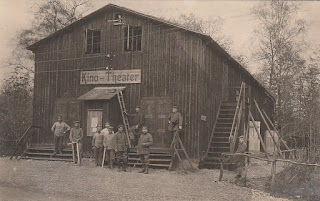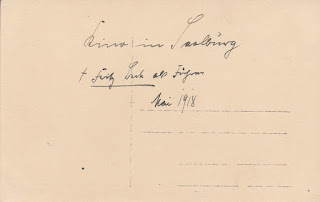This postcard is more of a photo than a postcard, but was intended (and probably sold) as a postcard. The place, person and time are noteworthy on the back - and this is how the cinema depicted can be identified.
Saalburg is not the little town in Thuringia on the river Saale, and not the Roman fort located on the main ridge of the Taunus, northwest of Bad Homburg in Hesse.
The German camp Saalburg was established during World War I near the occupied place of Autry, 50 km east of Reims. It is possible that the camp got its name after the Hessian fort of Saalburg. The camp and the place of Autry were destroyed by fighting in October 1918. Today there is forest and peace again.
Here I found an interesting article about the camp. Unfortunately, the cinema is not mentioned. Perhaps it was built in May 1918, as written on the postcard. I think the building was used as a cinema and theater.
The soldiers with the tools look like they have just finished the building. One of them is marked with a cross. The only one who doesn't look at the camera. Maybe it's the aforementioned Fritz Beck. I'm not sure what kind of "Führer" / leader Fritz Beck was. The head of cinema construction or the Vorführer / projectionist or the artistic director? I am sure that cinema-theater complied with all applicable German regulations.
Postcards in World War I are a very interesting topic. They show a desired self-expression. They are souvenirs for the army member themselves but also for their relatives and friends at home. When you look at the postcard, you think of a holiday camp for big boys rather than a war place.
At the same time, it is often not easy to locate postcards with front-line cinemas because they worked under exceptional conditions. There is little information about it - how many places there were, what was shown when, who performed, how was the film distribution. That's why this postcard with the comments is an important contemporary document.


Keine Kommentare:
Kommentar veröffentlichen